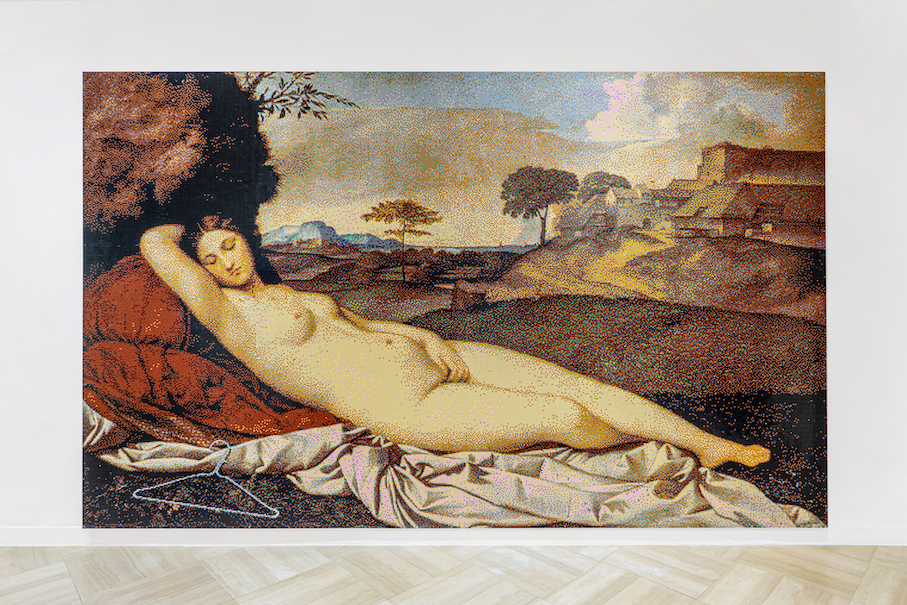It was 2013 when Mary Weatherford first laid eyes on Titian’s The Flaying of Marsyas. Taking in the composition’s brooding colors and eerie, violent stillness, the artist knew at that moment that she would one day create an exhibition surrounding the Renaissance masterpiece. Fast forward nearly a decade, and that vision has come to fruition at the Museo di Palazzo Grimani, coinciding with the 59th Biennale di Venezia.
Responding to Titian’s work, which depicts a scene as tragic as its title suggests, Weatherford has used her signature combination of Flashe paint and neon tubing to embody the tragic fate of the satyr in deep hues and gestural brushstrokes that harness the energy of the original. Taking over the museum’s second floor through November 27, the presentation was conceived with the help of the architect and designer Kulapat Yantrasast, who has arranged Weatherford’s suite of large-scale canvases within the walls of the ornate historic venue.
Curious about the making of the show and the compelling subject matter at hand, Whitewall spoke with the artist to learn more.
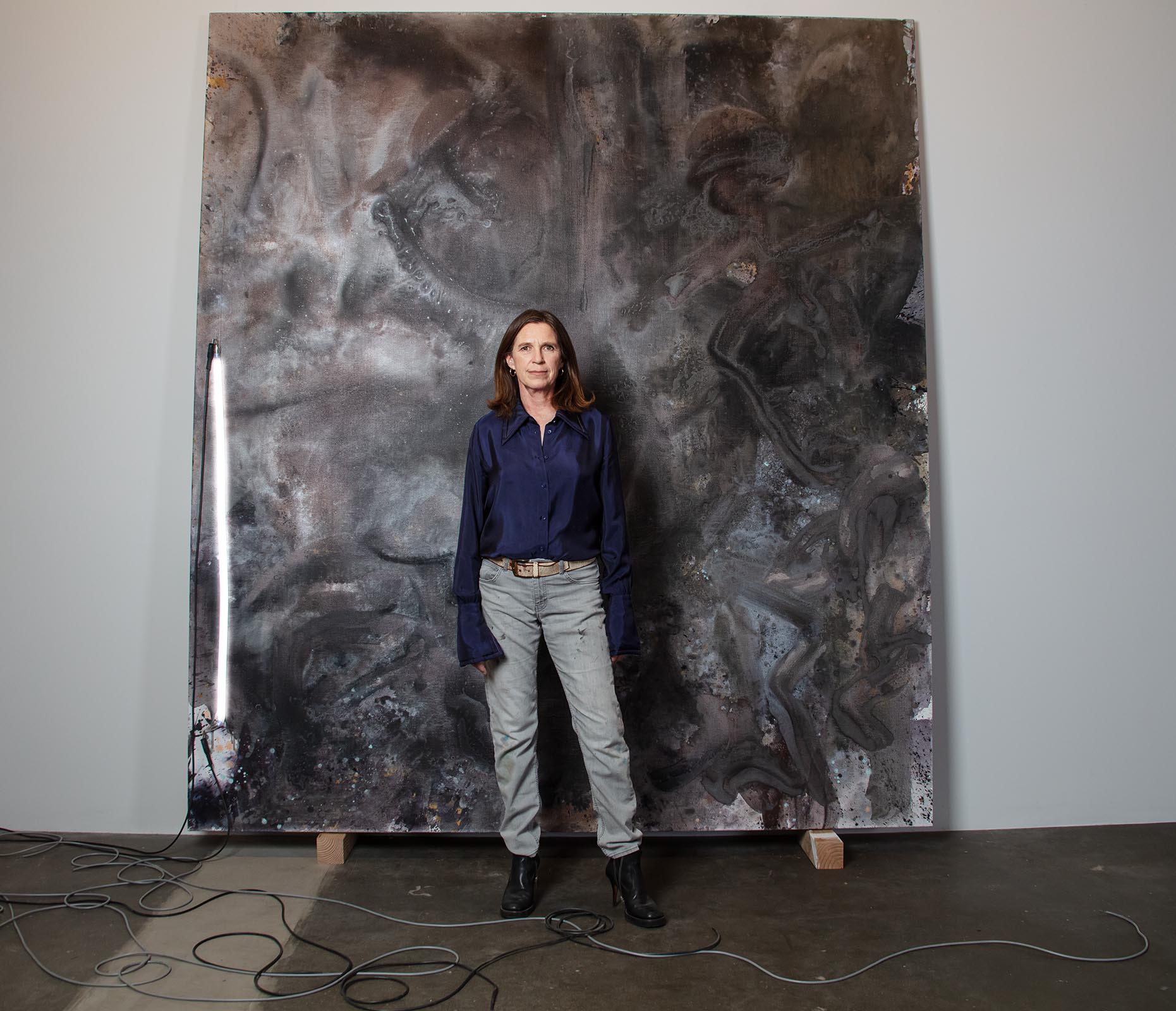
Mary Weatherford in her studio with “The Flaying of Marsyas—3500 Spectra” (2021–22), photo by Elena Dorfman, courtesy of Gagosian.
WHITEWALL: You said you first became drawn to Titian’s The Flaying of Marsyas after coming across it in 2013, and you immediately knew you’d create a responding exhibition someday. Why was that?
MARY WEATHERFORD: I saw it in Rome at a Titian exhibition. I was alone, and towards the end I found this painting. I’d never seen it before, nor had I studied it. I was struck by the power of the painting, the density of the figures, and the situation—which seemed unfair when one reads the setup.
As the myth goes, Marsyas, half-man, half-goat, and mortal, finds Athena’s panpipes on the ground. Marsyas picks them up, practices, and thinks of himself as a good musician. How it comes to pass that he challenged [God] Apollo to a music contest I can’t imagine, but he does. It’s agreed upon that the victor will inflict the punishment of his choice upon the vanquished. Apollo wins the contest because Apollo can play the lyre, and sing at the same time. The voice is deemed the most beautiful instrument. Apollo exacts the punishment that Marsyas will be flayed alive. The painting depicts the beginning of this scene.
In Murakami’s novel “The Wind-up Bird Chronicle”, there is a war scene of a flaying. I couldn’t unread it once I read it. I wish that I had not read it because it’s a terrible image. The scene haunted me, and then I saw this painting. I thought this was an evil painting because Apollo knew this would happen. What is so sad about the painting is the resigned look of horror on Marsyas’ face while the figure with the violin and the boy with the dog appeared unmoved by what’s happening.
It’s the structure Francis Ford Coppola employs in The Godfather—the famous montage of murders with soaring classical music. The music and the image are opposites, something often used in film. Freud writes about this mechanism of “representation by the opposite” at work in dreams, also at work in jokes.
In Titian’s painting (called The Punishment of Marsyas in Italian), the left side is the sacred and the right, the profane. I was struck by the incredible violence, a depiction of hubris, and a depiction of innocence, or ignorance, on the part of Marsyas. How could he ever think to challenge a God to a contest? In a way, he had it coming, which is an awful thought. I was also struck by the rawness of Titian’s painting. It’s nearly finger painting.
WW: How did you know that this was the right time to execute your response to the original painting?
MW: I woke up one morning last January and said to myself, “Time for the Flaying of Marsyas paintings.” I was struck by news images that reminded me of the painting. I painted these works very quickly with intense urgency. After I was finished painting, I had the thought that these would be difficult paintings to exhibit in a gallery. Gagosian proposed the Museo Palazzo Grimani [Venice] as a possibility. I have wanted to show neon paintings in Venice for a long time.
Venice is where my glass comes from. Italian post-war work has been influential. The Italian paintings I know best are Venetian, Tintoretto, Veronese, Bellini, Titian. I never thought that these factors would come together in one place so approriate as Grimani.
The titles of the works are all The Flaying of Marsyas followed by the name of the glass. I’ve been working with neon since 2012. When I envisioned this show I thought it would be a simple show in terms of the color of light because it’s a serious subject. The variations of neon are within the whites. Most of the glass is old Tecnolux glass, made in Venice and finished in Milan. Tecnolux was the classic and best glass when I started with neon light.
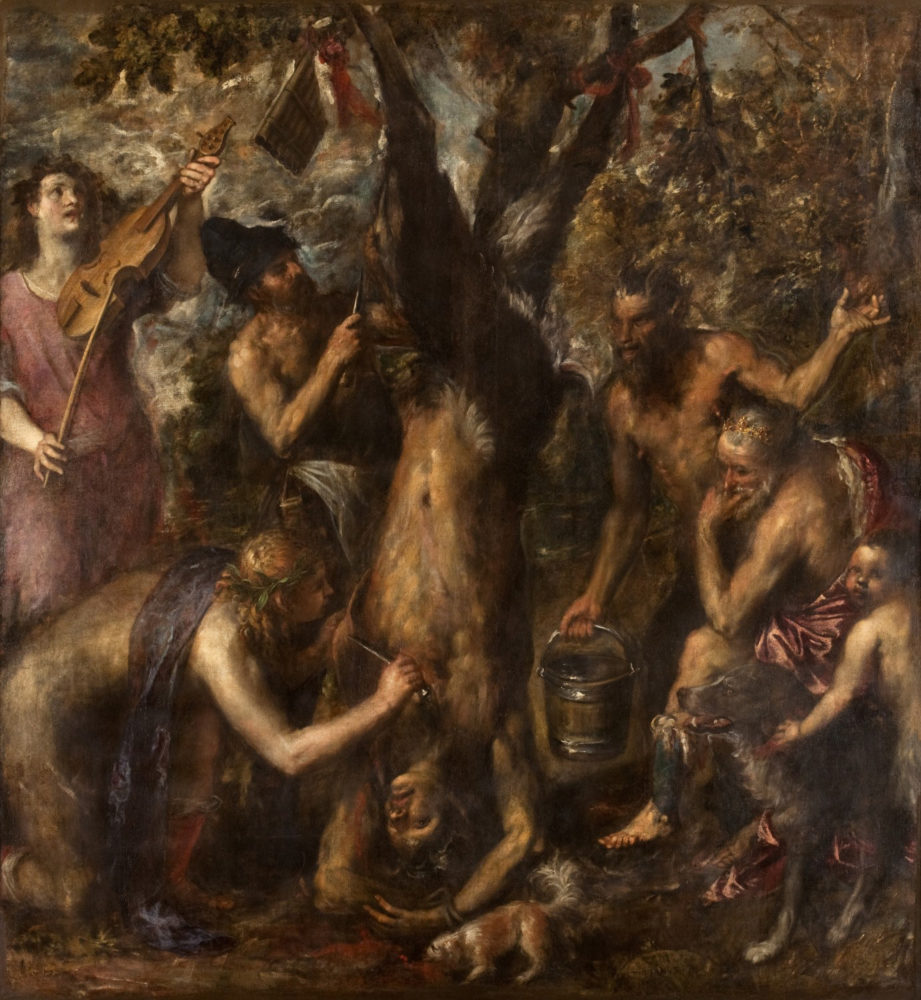
Titian, “The Flaying of Marsyas,” 1570-1576, Oil on canvas, 83 x 81 inches, Archbishopric of Olomouc – Archdiocesan Museum in Kromeriz; photo © Olomouc Museum of Art, Zdenek Sodoma.
WW: Which is the first painting you started with in the series?
MW: I’m not sure. I make the paintings in pairs. I painted either the very big paintings first, then the medium paintings, then the very small paintings at the end, almost as details of the larger pictures. I was fascinated with how much natural color – rich browns and greys – I could get out of the
Flasche paint I use.
WW: How did that influence the color and scale choice for you?
MW: The color is based on the Titian. The second time I saw the painting was at the Met Breuer in their opening show there, “Unfinished: Thoughts Left Visible”. The Met had opened in a brutalist building with a brutal painting to match. It was the first thing you saw when you got off the elevator. I was shocked. The painting was smaller than I remembered! In my imagination, the painting had grown in size over the years. Why do I paint on a large scale and a small scale? I started experimenting with scale when I began making mature work. I liked making tiny things and very big things. The small paintings are concentrated energy.
WW: How did your relationship with the original painting, and even with the artist Titian himself, evolve as these works came into being?
MW: I was happy to be thinking about Titian, Tintoretto, Bellini, and Veronese again. I came to Italy in 1995 alone. I went to churches and museums and looked at paintings. One never experiences that glory of painting in the United States. The Marsyas is an inspiring painting because I see it as the preview to Goya’s or Picasso’s depictions of war.
WW: How does the Palazzo Grimani add to the narrative of rediscovering Titian?
MW: It’s an extraordinary building and I am humbled to show these paintings in Venice. The architecture and the painting and the light in this city add up to an intoxicating experience.
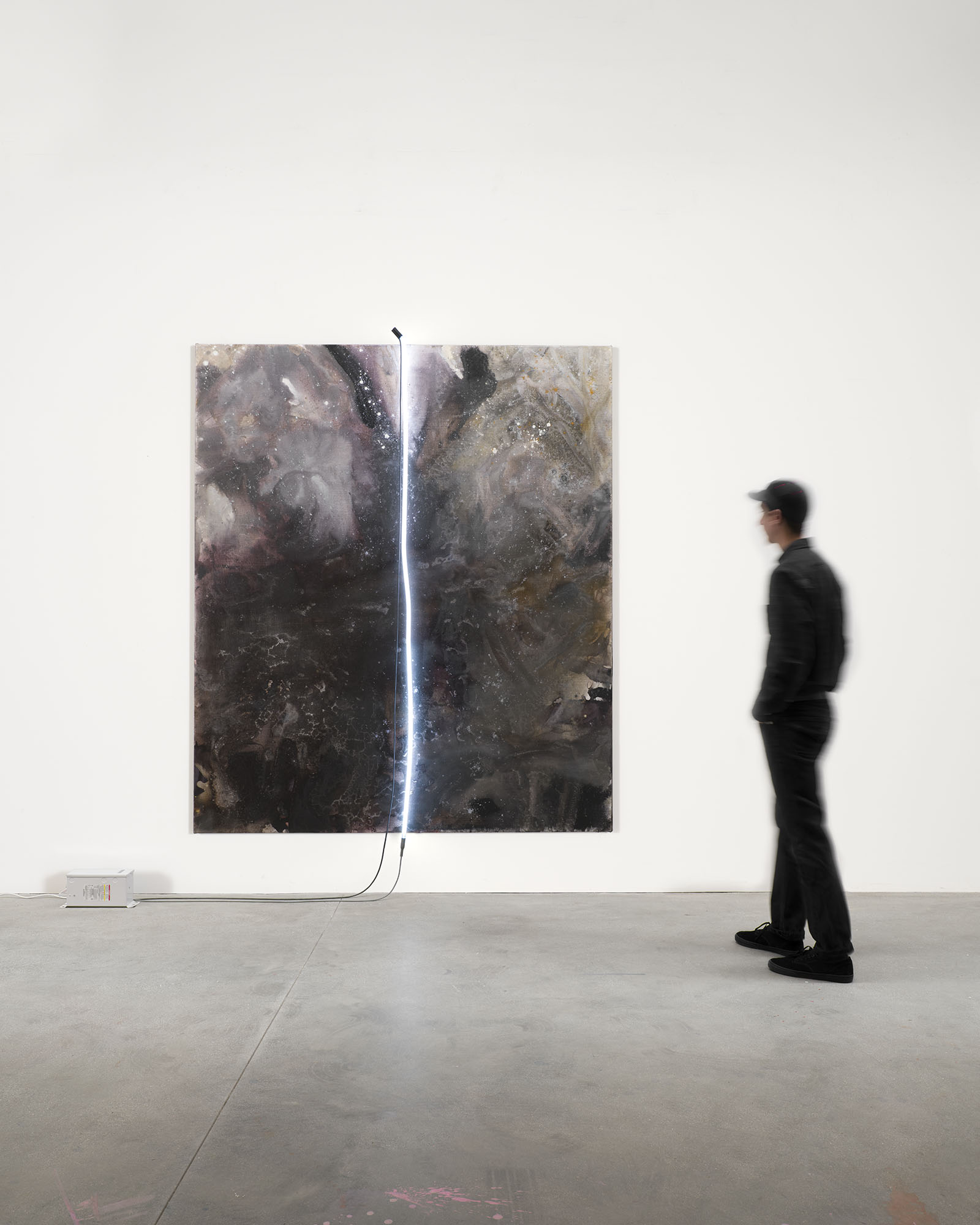
Mary Weatherford, “The Flaying of Marsyas—4500 Triphosphor,” 2021–22, Flashe and neon on linen, 93 x 79 inches; © Mary Weatherford, photo by Fredrik Nilsen Studio, courtesy of Gagosian.
WW: Can you tell us about your collaboration with architect and designer Kulapat Yantrasast?
MW: I met Kulapat at a party in Los Angeles. I was invited to his house (which he designed and built) in Venice beach. It has gigantic mechanical windows that open like wings, and a swimming pool that may be viewed from a single round underwater portal in the lower rooms. His firm, WHy Architecture designed the David Kordansky Gallery, where I also exhibit, and I liked the space. I respect his work and I asked him to architect my studio. I bought the old Weatherford and Wendt screw factory in Glendale, California. We are nearly finished transforming it into an art studio. When the Palazzo Grimani was proposed to me I said I want to work with an architect. To collaborate with Kulapat on the exhibition was fun and exciting.
The two of us made a site visit last November/December with the Gagosian team. The first room was bright with the wall of windows looking into the courtyard. His first intervention is the creation of the antechamber. Kulapat decided to make two walls (one with a round viewing portal!) to create a space where you know you’re entering into the exhibition. The walls have a thickness, so they draw the viewer in, announcing the drama about to take place.
The second intervention is a wall that covers the windows in the first gallery looking out onto a canal. I didn’t want the natural light to come pounding in the windows. I wanted the feeling of moving through a space you couldn’t completely know as the Palazzo.
WW: Your painting often incorporates lighted elements, and this show is no exception. How did your use of light as a medium aid the story you wanted to tell here?
MW: How and why would I bring neon light to an interpretation of Titian’s Flaying of Marsyas? The neon brings it into the present day. The paintings are semi-figurative. If you look hard enough, the figures emerge from the paint, and the intervention is a piece of light that functions as a cut in your visual field. There is one [painting] in there where Apollo is crawling under a cool light—almost as if he is in a horribly lit corridor. The last painting I made has no neon. It is a very small and dark painting functioning as a black hole that continues the theme. There is a dread, like a period at the end of a sentence. The lights are out.
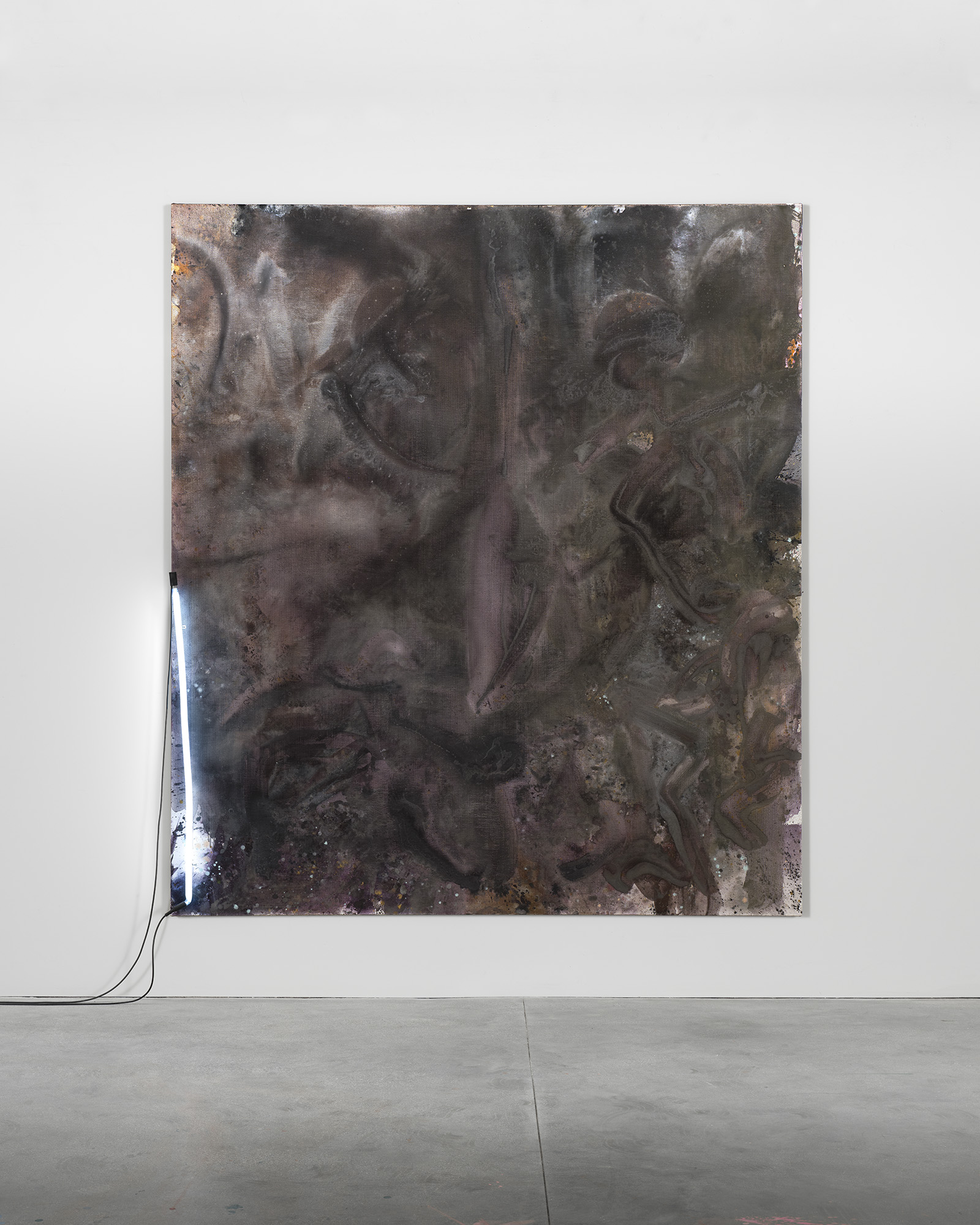
Mary Weatherford, “The Flaying of Marsyas—3500 Spectra,” 2021–22, Flashe and neon on linen, 112 x 99 inches; © Mary Weatherford, photo by Fredrik Nilsen Studio, courtesy of Gagosian.





